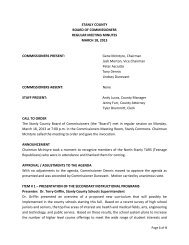Land Use Plan – 2002 - Stanly County, North Carolina
Land Use Plan – 2002 - Stanly County, North Carolina
Land Use Plan – 2002 - Stanly County, North Carolina
Create successful ePaper yourself
Turn your PDF publications into a flip-book with our unique Google optimized e-Paper software.
STANLY COUNTY<br />
likely to be capable of absorbing and sustaining new development with the least amount of<br />
public investment.<br />
A look at any map of the county tells this story. Fifteen of <strong>Stanly</strong> <strong>County</strong>’s schools are located<br />
within the corporate boundaries of the county’s eight municipalities, or within one mile of them.<br />
Four more—schools in Aquadale, Endy, and Millingport, and West <strong>Stanly</strong> High School—are<br />
located within an unincorporated town. <strong>Stanly</strong> <strong>County</strong>’s institutions of higher learning—Pfeiffer<br />
University in Misenheimer, and <strong>Stanly</strong> <strong>County</strong> Community College in Albemarle—are also<br />
located within established population centers. Most post offices are located within a city or town,<br />
and all but one of <strong>Stanly</strong> <strong>County</strong>’s 12 fire stations are located within or near a city or<br />
unincorporated town.<br />
The cities and towns of <strong>Stanly</strong> <strong>County</strong> also contain the most extensive road systems. Generally<br />
these roads are designed to provide a higher level of service than the farm-to-market roads in<br />
rural areas. Since many of the road systems in these communities are based on a grid system,<br />
they are easily expandable and can accommodate greater influxes of traffic, particularly during<br />
peak times.<br />
Expanding existing utility systems in communities throughout the county offers the best solution<br />
to providing affordable drinking water distribution and sewage treatment services to existing and<br />
new citizens in <strong>Stanly</strong> <strong>County</strong>. <strong>Stanly</strong> <strong>County</strong>’s water and sewer distribution and collection<br />
infrastructure are centered on distribution systems located within these communities.<br />
In support of this principle, strip commercial development along major highway corridors such as<br />
NC 24/27, NC 73, NC 49, and US 52 will need to be avoided. Presently an excellent model for<br />
this already exists in the study area since historically small-scale commercial activity has<br />
centered on smaller towns and crossroad settlements at major intersections along these<br />
corridors. Examples on the NC 24/27 corridor southwest of Albemarle include Red Cross and<br />
Endy. On NC 73 west of Albemarle, they include Plyler, Millingport, and Finger. Many other<br />
examples can be found in the county. While each one of these examples may not be able to<br />
support commercial activity—in some cases these towns and settlements will be undesirable<br />
places to develop—they do present a good model for future consideration.<br />
Focusing development to cities and towns also provides a means to help achieve the second<br />
major <strong>Land</strong> <strong>Use</strong> <strong>Plan</strong> principle, protecting <strong>Stanly</strong> <strong>County</strong>’s farmlands.<br />
2. Protect farming as an essential element of <strong>Stanly</strong> <strong>County</strong>’s<br />
future in terms of culture, economy, and land use.<br />
<strong>Stanly</strong> <strong>County</strong>’s history and culture is bound to the legacy of a farm economy. Farming continues<br />
to play an important role in the county’s economy, and is the second-largest single land use in<br />
the <strong>Land</strong> <strong>Use</strong> <strong>Plan</strong> study area. That role is slowly being threatened by the sprawling effects of<br />
low- to moderate-density residential development in all parts of the study area.<br />
<strong>Stanly</strong> <strong>County</strong> is not being threatened by urban sprawl like in Cabarrus and Union Counties.<br />
<strong>Stanly</strong> <strong>County</strong>’s sprawl problem is more tied to rural sprawl wherein farmland is increasingly<br />
interspersed by large-lot single-family residential properties as well as limited commercial and<br />
public/semi-public development. On many terms farming is as incompatible with residential<br />
development as an industrial activity such as a foundry or a mill. Farms produce noises, smells,<br />
dust, and other potentially unpleasant effects as a normal course of their operation.<br />
Unfortunately the state of <strong>North</strong> <strong>Carolina</strong> does not afford its farmers the protection of “right to<br />
farm” laws like other states. These laws protect farmers from nuisance complaints by residential<br />
neighbors. Farms are also supported by a road network specifically designed to meet the needs<br />
of the agricultural economy. Farmers often experience conflicts with drivers as large machinery<br />
is moved from field to field and from farm to market.<br />
<strong>Land</strong> <strong>Use</strong> <strong>Plan</strong> 6-4 6/02






